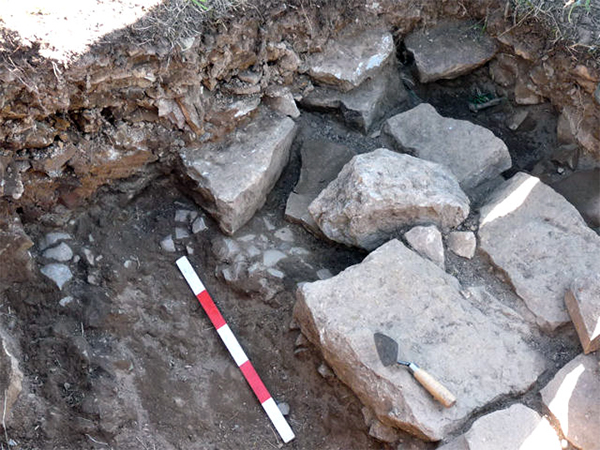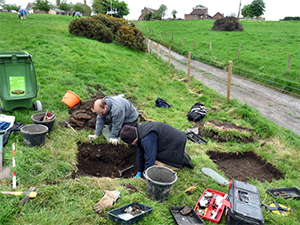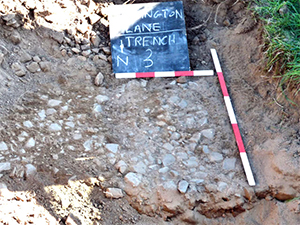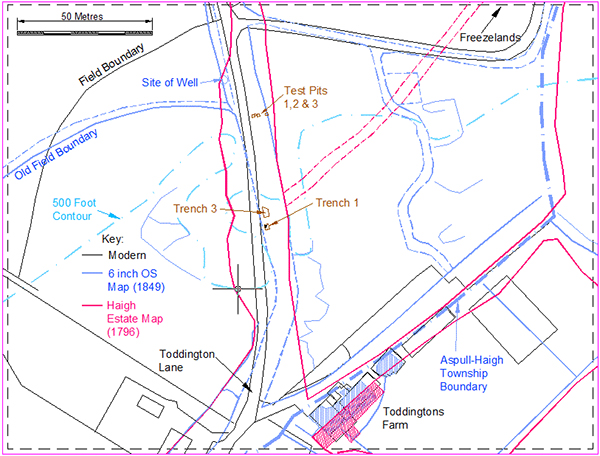
Things have moved on a pace since our report in last month's newsletter. Firstly we came across an estate map dating to the late 18th century, which shows Riley Lane and Meadow Pit Lane as proposed new roads. This proves that Toddington Lane was the original main road out towards Blackrod and Adlington. It also shows a track leading off across the fields towards Freezelands, a farm just a few hundred yards to the northeast of Toddingtons. This however was not in the place where it is now but further up the hill roughly where we are digging. Could our stone wall be the gateway entrance to this road?

Secondly, last month I mentioned a soil surface overlying more stone rubble. The stone rubble, however, turns out to be a well-worn cobble surface stretching, not just under our wall, but across the extent of our trench. This, we realised, must be the road shown on the 1849 map, proving (once again) that the 19th C cartographers new what they were doing. It also opens the question about whether we are looking at something much older. The only way to answer this would be to find the edges of the road, to see if they possess the ditches typical of 'ancient' construction. This would be impossible at our current location due to the overburden of quarry debris. Test pits were, therefore, opened about halfway further down the hill towards the tack leading to Freezelands where the field is more level with the track. Our first test pit, closest to the fence, revealed a surface lying just under the turf which was encouraging. Disappointingly, however, the metalling consisted of broken concrete roof tiles, similar to ones found in repairs of the current track.

Our second and third pits, dug at intervals of 1 and 2 metres respectively, produced the same result, albeit at different depths. A quick dumpy level check showed that the surfaces in each pit were level with each other. It is difficult to explain this modern material in the makeup of the surface as neither Mrs Pendlebury, nor the farmer at Freezelands, remember the area ever being exposed. Digging through the tile layer in test pit 1, however, did show that there is a stony layer underneath. We have also had chance now to digitise the various maps and, using a theodolite, survey in our trench locations (see below). This shows that perhaps we need to go further out with our test pits if we are to find the edge and perhaps try one on the other side of the road.
Finally the farmer at Toddingtons, Mrs Pendlebury's son, kindly arranged for a digger to come and remove the gorse from the area just down hill of our first trench. He also opened up a trench a few metres from the first to see if there was evidence of an opposing gatepost or wall. No sign of either was revealed but we did uncover the road surface, lying as before, under a band of soil at a depth of about half a metre. Still no evidence of its antiquity but it is intriguing to know that archaeology still survives at this depth. You can see more details and follow our progress on our blog site here: http://wiganarchsoc.co.uk/blog/?page_id=96 8

Dig GM Archaeology Festival
Acting as a partner to the GM Archaeology Day later in the year, this festival, running from the 22nd to 25th June, is designed to celebrate the region's rich archaeological heritage and the groups and individuals who are exploring it. Each member of the GM Federation is offering an event of one kind or another for the general public to get involved in. Our contribution is an invitation to join us on our excavations at Toddington Lane. For more information about this and the other events visit the blog site here: https://diggreatermanchester.wordpress.com/
Next Meeting
Wednesday 7th June. - in the Standish Suite at the Brocket Arms (7.30pm as usual). This month we have Karl Taylor from Oxford Archaeology North. Karl is their Geophysics expert and his talk will include recent projects where geophysics has been used by the unit to detect the archaeology. As you may have seen over the last few years, geophysics has proved a very useful tool for our Society, so it will be interesting to see how this essential tool is used by the professionals. Hope to see you then- BA
|



